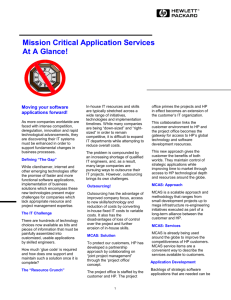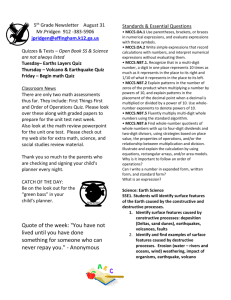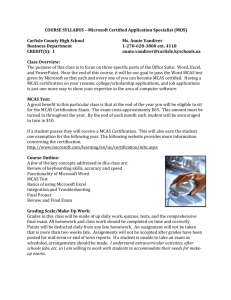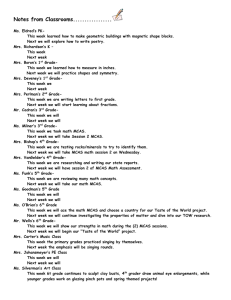Understanding Dementia Dementia is a clinical syndrome with a variety of etiologies
advertisement
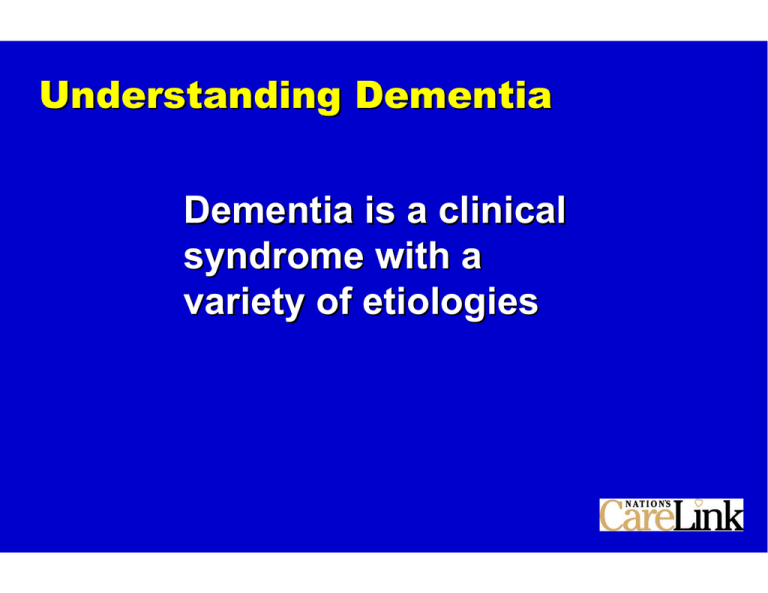
Understanding Dementia Dementia is a clinical syndrome with a variety of etiologies Cognitive Screening • Understanding Dementia • Dementia Testing Options • Dementia Testing Issues • Wrap Up Prevalence and Impact of AD • AD is the most common cause of dementia in people 65 years and older • Affects 10% of people over the age of 65 and 50% of people over the age of 85 • Approximately 4 million AD patients in the United States • Annual treatment costs = $100 billion • AD is the fourth leading cause of death in the United States • The overwhelming majority of patients live at home and are cared for by family and friends Evans DA. Milbank Q. 1990;68:267-289. Alzheimer’s Association. Available at: www.alz.org/hc/overview/stats.htm. Accessed 5/9/2001. High Cost of Dementia Treatment • 1.6X higher DIRECT health care charges each year • 1.7X more health care services each year • Dementia medication can SAVE $4839 in 24 months • Each case costs society $195,000 (primarily family) • Annual direct costs: Mild: $14,904 Moderate: $19,272 Severe: $25,860 Pathology of AD • There are 3 consistent neuropathological hallmarks: – – – Amyloid-rich senile plaques Neurofibrillary tangles Neuronal degeneration • These changes eventually lead to clinical symptoms, but they begin years before the onset of symptoms Selkoe DJ. JAMA. 2000;283:1615-1617. β-amyloid Plaques Immunocytochemical staining of senile plaques in the isocortex of a brain of a patient with AD Neurofibrillary Tangles Immunocytochemical staining of neurofibrillary tangles in the isocortex of a patient with AD The Progress of Alzheimer’s Disease Early diagnosis 30 Mild-moderate Severe Cognitive symptoms MMSE score 25 20 Loss of ADL 15 Behavioral problems 10 Nursing home placement 5 Death 0 0 0.5 1 1.5 2 2.5 3 3.5 4 4.5 5 5.5 6 6.5 7 7.5 Years Feldman H, Gracon S. In: Clinical Diagnosis and Management of Alzheimer’s Disease. 1996:239-253. 8 8.5 9 Treatment of Alzheimer’s Disease Patients (millions) 5 4,523,100 4 3 2,261,600 2 904,600 1 543,800 0 Prevalence Diagnosed Treated* * Any drug treatment, not limited to acetylcholinesterase inhibitors. Source: Decision Resources, March 2000. Treated with AChEIs AD Symptoms Correlate With Affected Areas of the Brain Motor cortex Primary somatic sensory cortex Central sulcus Parietal lobe Frontal lobe Prefrontal association cortex Parietaltemporaloccipital association cortex Occipital lobe Temporoparietal junction Temporal lobe Cummings JL. Am J Psychiatry. 2000;157:4-15. Van Hoesen GW et al. Cereb Cortex. 2000;10:243-251. Primary visual cortex Frontal Lobe Functions • • • • • • • • • Attention Span Organization-Flexibility Problem Solving Critical Thought-Judgement Motor Activity Memory Expressive Language Word Associations Sequencing Tasks Social Judgement • • • • • • • • MCAS Orientation MCAS Comprehension MCAS Repetition MCAS Naming MCAS Computation MCAS Judgement MCAS Verbal Fluency MCAS Attention Parietal Lobe Functions • • • • • • • • • Visual Attention-Touch Goal Directed Movement Object Manipulation Integrate Senses to Concept Object Naming (Anomia) Produce Writing (Agraphia) Drawing Objects Mathematics (Dyscalucuia) Space-Body Aware (Apraxia) • • • • MCAS Comprehension MCAS Naming MCAS Computation MCAS Verbal Fluency Temporal Lobe Function • • • • • • • Understanding Speech • Wernicke’s Apasia Memory Acquisition Object Categorization Limited Visual Perception Short Term Memory Long Term Memory Facial Recognition (Prosopagnosia) • • • • • • • MCAS Orientation MCAS Attention MCAS Delayed Word Recall MCAS Comprehension MCAS Repetition MCAS Naming MCAS Verbal Fluency Occipital Lobe Function • • • • • • Visual Object Location Vision Defects Recognizing Patterns Word Blindness Reading-Writing Object Movement Recognition • MCAS Comprehension Hippocampus / Enterorhinal Cortex • First Point of Attack by Alzheimer’s Neurofibrillary Tangles and Plaques • Limbic System-Underneath the Cortex • Working (Immediate) Memory transition to Short Term Memory. • The “Five Minute File Cabinet” • • • MCAS Delayed Word Recall MCAS Comprehension MCAS Verbal Fluency Complex, Time Consuming Neuropsychological Battery Luria-Nebraska or Halstead-Reitan Battery • Test a variety of cognitive functions: Concepts, Tactical Performances, Speech, Sensory Perceptions and Others • • • Both are Expensive > $1000 per administrations Several Hours of Administration Luria-Nebraska or Halstead-Reitan Battery Most appropriate in Special Settings – Specific Brain Injury - small stroke – Very Mild Impairment in Responsible Occupations • • • • • Physicians Executives Pilots Public Service: Police/Fire Contested Disability / Insurance Less ComplexGeneral Screening Most Common: WAIS-R (Weschler Adult Intelligent Scale - Revised) – – – – – Typically used in general psychiatric/ psychological practice Requires a psychologist to administer Less Expensive $200 - $300 per administration One or two hours: administration & scoring Least Complex Mass Screening • Used to screen general public • < 30 minute administration time • Psychologist not necessary • Various Forms Desirable Characteristics of Screening Tests • Should detect target condition earlier than without screening • Should have sufficient accuracy to avoid large numbers of false-positives or false-negatives • Should be inexpensive and quick • Should be convenient for the patient/client • Should be straightforward to administer Effectiveness of 2nd Generation Screens Sensitivity Specificity Reliability MCAS 97.5% 98.45% 0.93 D.W.R. 89%-96% 98%-100% 0.75 96% 0.91 7-Minute Screen 92% Alzheimer’s Disease Treatment • Estrogen: limited data • Vitamin E: low risk, possible benefit • NSAIA: ibuprofen, limited data • Ginko Biloba: very limited data, low risk • Acetylchoinesterase Inhibitors: • Cognex (tacrine), Exelon (rivastigmine) • Aricept (donezepil), Reminyl (galantamine) *Alzheimer’s Disease Assessment Scale - Cognitive Subscale. †P<0.05 vs projected placebo. Farlow M, et al. European Neurology 2000. In press. Responders After 6 Months of Treatment with Exelon Mild Cognitive Impairment 10 - 12% develop dementia each year vs. control populations: 1 - 2% each year Critical Diagnosis Population for medication intervention • • • • • Memory complaint Normal ADL’s Normal general cognition function Abnormal memory for age Not demented Update on the MCAS • Currently in use with 27 LTC Insurers – – Telephonic & Face-to-Face Underwriting & Claims • Growing Interest from Life Insurers • Numerous Research Projects Pending • Working on Medicare Coding Summary • Cognition is complex • Accurate testing is difficult and has limitations • Can spend a lot of money and time and get exceptional results • Can get reasonably reliable results with a well constructed mass screening test QUESTIONS

